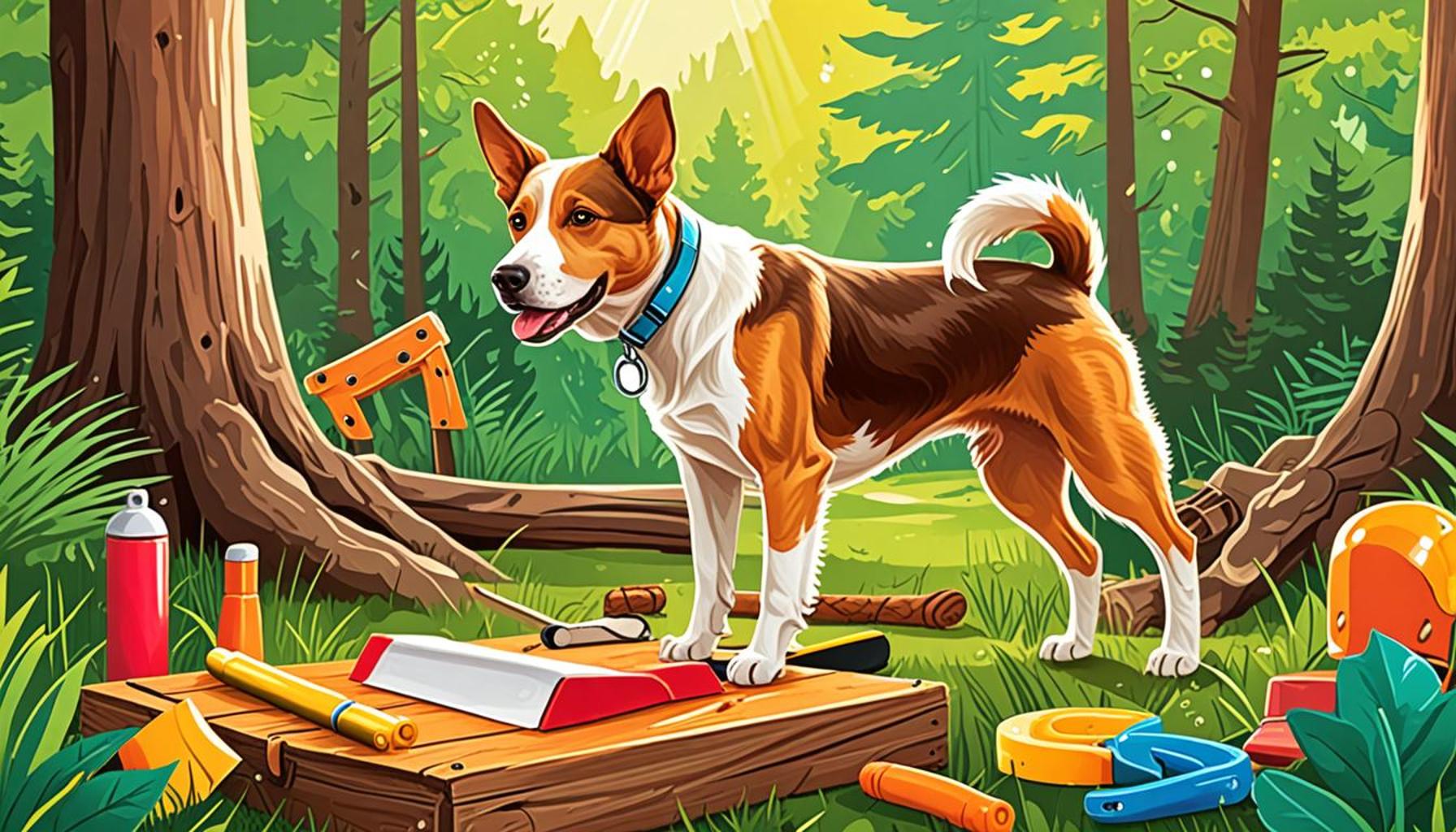Dog Training for Outdoor Activities: Strategies for Safe Adventures

Unleashing Adventure: Training Your Dog for the Great Outdoors
When it comes to outdoor fun, our canine companions deserve to join in on the excitement. However, ensuring safety during these adventures requires careful dog training tailored specifically for the outdoors. Understanding how to train your dog effectively can transform your excursions into enjoyable, stress-free experiences that both you and your pet will cherish.
What are some essential elements to consider for successful outdoor quests with your furry friend? Here are a few key strategies:
- Basic Commands: Teaching your dog fundamental commands such as “come,” “sit,” and “stay” is crucial for promoting safety and cooperation. For instance, during a hike, a solid “come” command can prevent your dog from wandering too far or chasing after wildlife. Practicing these commands in different environments, especially in places similar to where you’ll be adventuring, will help prepare your dog for the unexpected.
- Leash Training: Proper leash manners can make a significant difference in ensuring both your and your dog’s safety. You might consider using a front-clip harness, which not only provides more control but also discourages pulling. Engaging in regular leash training sessions in various environments—like parks or beaches—can help your dog learn how to walk calmly and respectfully beside you, even amidst distractions.
- Socialization: Familiarizing your dog with other pets and people enhances their confidence and comfort in public settings. Organized dog meet-ups at local parks can be beneficial. For example, attending a dog-friendly picnic can expose your pet to various stimuli, teaching them to remain calm and well-behaved in bustling environments.
- Trail Etiquette: Teaching your dog to be respectful of wildlife, other hikers, and the environment is key to a harmonious adventure. You can practice this by showing them how to “leave it” when encountering animals or objects that may be tempting to chase or investigate. This not only protects the wildlife but also keeps your dog safe from harm.
Each of these elements serves as a building block for a more enjoyable outdoor experience. By investing time in preparing your dog for these adventures, you’re laying the foundation for a lifetime of memorable outings. For example, consider embarking on a weekend camping trip equipped with all the training you’ve implemented; the thrill of watching your dog explore a new terrain with confidence and curiosity will elevate your experience.
Are you ready to delve into these dog training strategies that promote fun and safety? Let’s explore how to make every hiking trip, beach day, or camping experience an adventure worth sharing! With a little effort and ample love, your four-legged friend can become the ideal companion for life’s great outdoor adventures.
DISCOVER MORE: Click here for insights on pet food choices

Key Strategies for a Safe Outdoor Experience
Preparing your canine companion for outdoor activities is a rewarding experience, but it requires more than just enthusiasm. A comprehensive training plan helps ensure both safety and enjoyment during your adventures together. Each outdoor excursion presents unique challenges, and understanding how to navigate those is essential for creating a positive experience. Here are vital training strategies to consider:
- Building a Strong Recall: A reliable “come” command can be lifesaving when you’re out in nature. Start training this command in a distraction-free environment before gradually introducing more stimulating settings, like parks or trails. Use high-value treats or toys to make coming back to you more appealing. Regularly practicing this command can help your dog learn to prioritize your signal over the allure of wildlife or other distractions.
- Desensitization to Natural Environments: Dogs may find new outdoor settings stimulating or even overwhelming. Take time to introduce your dog to different environments, such as wooded areas, beaches, or rocky terrains. Gradually increase the level of noise and distraction. The goal is to help your dog acclimate and feel at ease in varied settings, thereby decreasing anxiety and unwanted behaviors when on an adventure.
- Impulse Control Training: Teaching your dog impulse control is crucial—this means training your dog to wait patiently rather than rushing toward a new sight, sound, or smell. Exercises like “wait” and “leave it” can be trained through rewards and consistent practice. These commands not only promote good behavior but also keep your dog out of dangerous situations.
- Exploring with an Engaging Routine: Make outdoor excursions exciting by incorporating varied activities. This can include hiking, swimming, or playing fetch at a lake. Varying your routine can prevent boredom, which often leads to undesirable behaviors. Additionally, incorporating agility training can be beneficial, utilizing local parks with agility equipment to keep your dog’s body and mind active.
- Pack Familiarization: If you’re planning to take your dog on camping trips, introducing them to their gear—like a backpack or dog bed—can help them feel more comfortable during outings. Allow your pup to explore their items at home before embarking on your journey, so they associate their equipment with positive experiences.
Each training activity represents an essential step toward enhancing your dog’s outdoor experience. By diligently preparing your pet with these strategies, you not only prioritize their safety but also pave the way for enriching adventures amidst nature. Whether it’s exploring rugged trails or enjoying a day at the beach, well-trained dogs are more likely to respond appropriately to potential hazards they may encounter.
Are you eager to elevate your dog’s training for outdoor adventures? Let’s delve deeper into developing a relationship built on trust, communication, and exploration that becomes the foundation for countless thrilling outings!
| Category | Details |
|---|---|
| Communication Skills | Effective dog training enhances communication between the handler and the dog, crucial for outdoor safety. |
| Building Confidence | Proper training fosters confidence in dogs, allowing them to navigate diverse outdoor terrains and scenarios. |
| Socialization Opportunities | Exposing dogs to various environments during training helps them adapt and behave appropriately around other dogs and people. |
| Health Benefits | Engaging in outdoor activities promotes physical fitness and mental stimulation, key elements for a happy, healthy dog. |
Exploring the great outdoors with your dog can be thrilling, but practical training is essential to ensure both safety and enjoyment. Emphasizing communication skills during training sessions creates a robust bond that can prevent misunderstandings in unfamiliar environments. This foundation not only improves obedience but also strengthens your dog’s ability to respond in critical situations.Moreover, building confidence through exposure to various outdoor activities enables dogs to handle unexpected changes and challenges adeptly. Training acts as an invaluable opportunity for dogs to socialize, allowing them to interact positively with different species, a crucial part of their development.Lastly, consistent engagement in outdoor adventures correlates with numerous health benefits, ensuring your dog remains fit, alert, and mentally stimulated. These aspects of dog training not only enhance the adventure but also elevate the overall experience for both the handler and the furry companion.
DISCOVER MORE: Click here to learn about the best options for your pet
Enhancing Outdoor Safety with Socialization and Training
In addition to the foundational training strategies, socialization plays a pivotal role in ensuring a safe and enjoyable outdoor experience for your dog. Socializing your dog with different animals, people, and environments not only fosters better behavior but also builds their confidence. Here are several approaches to enhance outdoor safety through effective socialization and specialized training techniques:
- Positive Exposure to Other Dogs: Arrange playdates with friendly dogs in your neighborhood. Supervised interactions can help your dog learn appropriate social cues. Always start in a controlled environment before progressing to busier locations, such as dog parks, where your dog will encounter multiple canine personalities and play styles. This gradual exposure helps mitigate aggressive tendencies and fear-based reactions.
- Training for Off-Leash Adventures: To enjoy the freedom of off-leash hiking or running, your dog must master basic obedience commands alongside strong impulse control. Around other dogs or wildlife, consistent recall training is essential. Many dog trainers recommend utilizing a long line leash during these sessions, allowing your dog some freedom while maintaining control, ensuring safety and reinforcing reliable recall habits.
- Canine Good Citizen Program: Consider enrolling your dog in a Canine Good Citizen (CGC) program. This training provides valuable skills that contribute to responsible pet ownership and ensures your dog behaves in public settings. By mastering 10 specific skills such as greeting strangers and supervised separation, your dog will be well prepared for outdoor activities in diverse environments.
- Awareness of Wildlife and Other Hazards: Educate your dog on recognizing possible dangers in natural settings. Training your dog to “leave it” can be especially beneficial when encountering wildlife or unfamiliar objects. For instance, if your dog spots a squirrel or comes across potentially harmful items like sharp objects or toxic plants, their ability to heed this command could prevent unwanted incidents.
- Stay Hydrated and Know Your Limits: Ensure your outdoor adventures are safe by monitoring your dog’s energy levels and hydration. Carry water and a collapsible bowl during your outings—especially on warmer days. Learning the signs of overheating or fatigue is vital. Dogs may exhibit excessive panting, drooling, or reluctance to move. Understanding your dog’s limits can prevent overheating and injuries during active outings.
- Equipment Familiarity for Enhanced Comfort: While harnesses and collars play critical roles in outdoor adventures, your dog should also feel comfortable with any additional gear, such as acclimating them to wearing booties to protect against rocky terrains or hot pavement. Proper gear not only promotes safety but can also prevent discomfort that may detract from your excursion.
By emphasizing the importance of socialization, consistent training, and building a strong relationship with your dog, both of you will be well-equipped for a multitude of outdoor activities. Investing in your dog’s training and preparedness opens up a world of exploration, allowing you to safely enjoy nature together while strengthening your bond.
DISCOVER MORE: Click here to find out what’s best for your pet
Final Thoughts on Dog Training for Safe Outdoor Adventures
Embarking on outdoor adventures with your dog can be an immensely rewarding experience, provided that safety and training are prioritized. By implementing effective training strategies and ensuring proper socialization, you lay the groundwork for a harmonious relationship that enhances not only your dog’s behavior but also the joy of your shared explorations. From the fundamentals of obedience commands to advanced techniques like reliable recall and hazard recognition, each training aspect serves to empower both you and your furry companion.
Additionally, recognizing the importance of proper equipment and hydration can elevate your outdoor experiences to new heights. Utilizing tools such as long line leashes and keeping your dog hydrated ensures their comfort and safety, while acclimating them to necessary gear can enhance their enjoyment during activities. By embracing these strategies, you prepare both yourself and your dog for a wide range of outdoor challenges, whether it’s hiking through national parks or simply enjoying a stroll in your neighborhood.
Ultimately, the journey of dog training is an ongoing adventure itself—an opportunity for continuous learning and bonding that enhances both your skills as a handler and your pet’s adaptability in different scenarios. Opening the door to outdoor activities not only nurtures your dog’s mental and physical health but also strengthens the bond you share as partners in exploration. Take the leap, embark on new adventures, and embrace the wonderful world that awaits you and your dog in nature!


